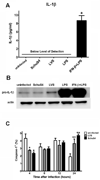IFN-β mediates suppression of IL-12p40 in human dendritic cells following infection with virulent Francisella tularensis
- PMID: 21753150
- PMCID: PMC3150225
- DOI: 10.4049/jimmunol.1100377
IFN-β mediates suppression of IL-12p40 in human dendritic cells following infection with virulent Francisella tularensis
Abstract
Active suppression of inflammation is a strategy used by many viral and bacterial pathogens, including virulent strains of the bacterium Francisella tularensis, to enable colonization and infection in susceptible hosts. In this study, we demonstrated that virulent F. tularensis strain SchuS4 selectively inhibits production of IL-12p40 in primary human cells via induction of IFN-β. In contrast to the attenuated live vaccine strain, infection of human dendritic cells with virulent SchuS4 failed to induce production of many cytokines associated with inflammation (e.g., TNF-α and IL-12p40). Furthermore, SchuS4 actively suppressed secretion of these cytokines. Assessment of changes in the expression of host genes associated with suppression of inflammatory responses revealed that SchuS4, but not live vaccine strain, induced IFN-β following infection of human dendritic cells. Phagocytosis of SchuS4 and endosomal acidification were required for induction of IFN-β. Further, using a defined mutant of SchuS4, we demonstrated that the presence of bacteria in the cytosol was required, but not sufficient, for induction of IFN-β. Surprisingly, unlike previous reports, induction of IFN-β by F. tularensis was not required for activation of the inflammasome, was not associated with exacerbation of inflammatory responses, and did not control SchuS4 replication when added exogenously. Rather, IFN-β selectively suppressed the ability of SchuS4-infected dendritic cells to produce IL-12p40. Together, these data demonstrated a novel mechanism by which virulent bacteria, in contrast to attenuated strains, modulate human cells to cause disease.
Figures






Similar articles
-
Interleukin-17 protects against the Francisella tularensis live vaccine strain but not against a virulent F. tularensis type A strain.Infect Immun. 2013 Sep;81(9):3099-105. doi: 10.1128/IAI.00203-13. Epub 2013 Jun 17. Infect Immun. 2013. PMID: 23774604 Free PMC article.
-
Francisella tularensis SchuS4 and SchuS4 lipids inhibit IL-12p40 in primary human dendritic cells by inhibition of IRF1 and IRF8.J Immunol. 2013 Aug 1;191(3):1276-86. doi: 10.4049/jimmunol.1300867. Epub 2013 Jul 1. J Immunol. 2013. PMID: 23817430 Free PMC article.
-
The presence of CD14 overcomes evasion of innate immune responses by virulent Francisella tularensis in human dendritic cells in vitro and pulmonary cells in vivo.Infect Immun. 2010 Jan;78(1):154-67. doi: 10.1128/IAI.00750-09. Epub 2009 Oct 19. Infect Immun. 2010. PMID: 19841074 Free PMC article.
-
Live Attenuated Tularemia Vaccines for Protection Against Respiratory Challenge With Virulent F. tularensis subsp. tularensis.Front Cell Infect Microbiol. 2018 May 15;8:154. doi: 10.3389/fcimb.2018.00154. eCollection 2018. Front Cell Infect Microbiol. 2018. PMID: 29868510 Free PMC article. Review.
-
Francisella Inflammasomes: Integrated Responses to a Cytosolic Stealth Bacterium.Curr Top Microbiol Immunol. 2016;397:229-56. doi: 10.1007/978-3-319-41171-2_12. Curr Top Microbiol Immunol. 2016. PMID: 27460813 Review.
Cited by
-
The Early Dendritic Cell Signaling Induced by Virulent Francisella tularensis Strain Occurs in Phases and Involves the Activation of Extracellular Signal-Regulated Kinases (ERKs) and p38 In the Later Stage.Mol Cell Proteomics. 2018 Jan;17(1):81-94. doi: 10.1074/mcp.RA117.000160. Epub 2017 Oct 18. Mol Cell Proteomics. 2018. PMID: 29046388 Free PMC article.
-
Virulent Francisella tularensis destabilize host mRNA to rapidly suppress inflammation.J Innate Immun. 2014;6(6):793-805. doi: 10.1159/000363243. Epub 2014 May 27. J Innate Immun. 2014. PMID: 24902499 Free PMC article.
-
Virulent Type A Francisella tularensis actively suppresses cytokine responses in human monocytes.Front Cell Infect Microbiol. 2014 Apr 10;4:45. doi: 10.3389/fcimb.2014.00045. eCollection 2014. Front Cell Infect Microbiol. 2014. PMID: 24783062 Free PMC article.
-
Interleukin-17 protects against the Francisella tularensis live vaccine strain but not against a virulent F. tularensis type A strain.Infect Immun. 2013 Sep;81(9):3099-105. doi: 10.1128/IAI.00203-13. Epub 2013 Jun 17. Infect Immun. 2013. PMID: 23774604 Free PMC article.
-
Metabolic Reprogramming of Host Cells by Virulent Francisella tularensis for Optimal Replication and Modulation of Inflammation.J Immunol. 2016 May 15;196(10):4227-36. doi: 10.4049/jimmunol.1502456. Epub 2016 Mar 30. J Immunol. 2016. PMID: 27029588 Free PMC article.
References
-
- Bosio CM, Aman MJ, Grogan C, Hogan R, Ruthel G, Negley D, Mohamadzadeh M, Bavari S, Schmaljohn A. Ebola and Marburg viruses replicate in monocyte-derived dendritic cells without inducing the production of cytokines and full maturation. J Infect Dis. 2003;188:1630–1638. - PubMed
-
- Bosio CM, Bielefeldt-Ohmann H, Belisle JT. Active suppression of the pulmonary immune response by Francisella tularensis Schu4. J Immunol. 2007;178:4538–4547. - PubMed
Publication types
MeSH terms
Substances
Grants and funding
LinkOut - more resources
Full Text Sources

